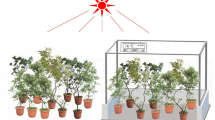Abstract
The rhizome age structure for populations ofPhragmites australis (Cav.) Trin. exSteud. was determined at three sites of the Třeboň Biosphere Reserve (Czech Republic). These sites were classified according to plant species composition and phosphorus availability as oligotrophic (Branná), mesotrophic (Rožmberk East) and hypertrophic (Rožmberk West).P.australis stands at these sites were expanding, stabilized and retreating, respectively. Rhizomes were sampled within the terrestrial parts of the reed stands (at a water depth of about 10 cm). The rhizomes were dated according to the position in the branching hierarchy and to supplementary morphological criteria. The analysis of the branching pattern revealed that at the sites studied, the rhizomes typically branch only once a year. The longest life span of rhizomes (six years) was found for the stable reed population at Rožmberk East. The reduced rhizome life span at Rožmberk West (four to five years), accompanied by a reduced branching frequency of horizontal rhizomes, was ascribed to a greater incidence of anaerobic conditions associated with the permanent flooding of the hypertrophic organic soil. The maximum life span of the Branná population (four years) probably corresponds to the total age of the reed population. The concentrations of nitrogen, phosphorus, and potassium in the tissue decreased with rhizome age while those of calcium and magnesium increased. The effect of rhizome age on mineral-nutrient concentrations was more pronounced than the effect of site on these concentrations. The mineral nutrient concentrations were not closely associated with reed performance.
Similar content being viewed by others
References
Armstrong J., Armstrong W., Wu Z. &Afreen-Zobayed F. (1996): A role for phytotoxins in thePhragmites die-back syndrome?Folia Geobot. Phytotax. 31: 127–142.
Čížková H. &Bauer V. (1998): Rhizome respiration ofPhragmites australis: Effect of rhizome age, temperature, and nutrient status of habitat.Aquatic Bot. 61: 239–253.
Čížková H., Kopecký J., Brabcová H., Bauer V. &Lukavská J. (1995) Carbohydrate levels in rhizomes ofPhragmites australis (Cav.) Trin. exSteudel as related to nutrient availability. In:van der Putten W.H. (ed.),Reednews 4, Final report to the EU project No. EV5V-CT92-0083 (EUREED), Netherlands Institute of Ecology, Heteren, Supplement, pp. 1–25.
Čížková H., Strand J. &Lukavská J. (1996): Factors associated with reed decline in a eutrophic fishpond, Rožmberk, Czech Republic.Folia Geobot. Phytotax. 31: 73–84.
Čížková-Končalová H., Květ J. &Thompson K. (1992): Carbon starvation: a key to reed decline in eutrophic lakes.Aquatic Bot. 43: 105–113.
Dykyjová D. (1978): Nutrient uptake by littoral communities of helophytes. In:Dykyjová D. &Květ J. (eds.),Pond littoral ecosystems, Springer Verlag, Berlin, pp. 257–277.
Fiala K. (1976): Underground organs ofP. communis, their growth, biomass and net production.Folia Geobot. Phytotax. 11: 225–259.
Haslam S. (1969a): Stem types ofPhragmites communis Trin.Ann. Bot. 33: 127–131.
Haslam S. (1969b): The development and emergence of buds inPhragmites communis Trin.Ann. Bot. 33: 289–301.
Haslam S. (1970): Variation in the population type inPhragmites communis Trin.Ann. Bot. 34: 147–158.
Javorský J. (1982):Chemické rozbory v zemědělských laboratořích (Chemical analyses in agricultural laboratories). Ministerstvo zemědělství, Praha.
Kubín P. &Melzer A (1996): Chronological relationships between eutrophication and reed decline in three lakes of southern Germany.Folia Geobot. Phytotax. 32: 15–23.
Kühl H. &Kohl J.-G. (1993): Seasonal nitrogen dynamics in reed beds (Phragmites australis (Cav.)Trin exSteudel) in relation to productivity.Hydrobiologia 251: 1–12.
Květ J. (1973): Mineral nutrients in shoots of reed (Phragmites communis Trin.).Polskie Arch. Hydrobiol. 20: 137–147.
Marschner H. (1985):Mineral nutrition of higher plants. Academic Press, London.
Ostendorp W. (1989): “Die-back” of reeds in Europe—a critical review of literature.Aquatic Bot. 35: 5–26.
Pechar L. (1995): Long-term changes in the fishpond management as an unplanned ecosystem experiment— importance of zooplankton structure, nutrients and light for species composition of cyanobacterial blooms.Water Sci. Technol. 32: 187–196.
Pokorný J., Schlott G., Schlott K., Pechar L. & Koutníková J. (1994): Monitoring of changes in fishpond ecosystems. In:Aubrecht G., Dickland G. & Prentice C. (eds.),Monitoring of ecological change in wetlands of Middle Europe, Proc. Int. Workshop Linz, Austria, 1993, Stapfia 31: 37–45.
Schierup H.-H. (1978): Biomass and primary production in aPhragmites communis Trin. swamp in North Jutland, Denmark.Verh. Int. Vereinigung Limnol. 20: 94–99.
van der Putten W.H. (1997): Die-back ofPhragmites australis in European wetlands: an overview of the European Research Programme on Reed Die-Back and Progression (1993–1994).Aquatic Bot. 59: 263–275.
Author information
Authors and Affiliations
Corresponding author
Rights and permissions
About this article
Cite this article
Čížková, H., Lukavská, J. Rhizome age structure of three populations ofPhragmites australis (Cav.) Trin. ex Steud.: Biomass and mineral nutrient concentrations. Folia Geobot 34, 209–220 (1999). https://doi.org/10.1007/BF02913396
Received:
Revised:
Issue Date:
DOI: https://doi.org/10.1007/BF02913396




